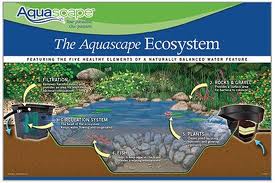You are here
Aquascape Ecosystem
The “Aquascape Ecosystem” features five healthy elements of a naturally-balanced water feature:
 Mechanical and Biological Filtration
Mechanical and Biological Filtration- Pond Boulders, River Gravel, and Bacteria
- Recirculation System and Oxygenation
- Fish
- Aquatic Plants
Eliminating just one of these elements will cause your ecosystem to be out-of-balance. The Aquascape Ecosystem is a PROVEN system!
Ecosystem Ponds
Ecosystem ponds can be easy to understand if you have a good grasp of what components go into a basic, functioning ecosystem. An ecosystem pond works with Mother Nature to provide food, shelter, and safety to the wildlife around it. It also provides you with an all-natural, low-maintenance piece of paradise. It’s important to remember, however, that every piece of the ecosystem puzzle must be present in order for a true ecosystem to be in place. Eliminate one of these elements and you’ve got an unbalanced ecosystem that won’t be so low-maintenance anymore. Check out the things you’ll need to get your ecosystem pond fired up:
Check out the video below to see an ecosystem pond that we designed and installed:
Mechanical and Biological Filtration
Proper Filtration System includes the use of both a biological and a mechanical filter. A biological filter provides surface area for beneficial bacteria to colonize and remove excess nutrients from the water. A biological filter is more commonly called the “biofall.” A mechanical filter will not only pre-filter the water and house the pump; it will also skim debris from the water’s surface to prevent the accumulation of organic materials on the pond floor. It is more commonly called the “skimmer.”
Rocks, Gravel, and Bacteria
Using rocks and gravel in the pond have been a controversial element in the hobby for many years. For those of us who are familiar with Lilypons in Frederick this has been made all too apparent and sometimes causes confusion. They adamantly promote liner-only ponds with no rocks and gravel even saying that it is not healthy for Koi to live amongst rocks and gravel. This perspective has caused many enthusiasts to avoid rocks and gravel out of fear that their system will become a maintenance nightmare and harm their fish.

On the contrary, rocks and gravel will not only make your pond look more natural, they will also protect pond liners from UV light degradation, and they provide tremendous surface area for beneficial bacteria to break down excess nutrients in the water and dissolved organic debris on the pond floor. Rocks and gravel are an absolute necessity in the Aquascape Ecosystem Pond! Because we routinely clean all sorts of ponds—even those we did not build—we know which ones have the most sludge at the bottom: The liner-only ponds are always filled with slippery, stinky, black sludge, sometimes up to 1’ deep. Not so with rock and gravel ponds.
Circulation System
This is really just a fancy way of saying “pumps and plumbing.” The proper size pump and pipe diameter are extremely important for the aesthetics of a water feature. More importantly, an efficient circulation system keeps the water moving and provides the necessary oxygen levels for healthy fish and plants.
Fish
Fish are an integral part of any ecosystem. Unfortunately, fish are often seen as creating a maintenance nightmare. Contrary to popular belief, fish will actually reduce pond maintenance, as they graze on string algae and bottom feed from the pond floor. Fish are the highlight of any pond whether you choose ornamental fish like Koi or goldfish or even game fish like bluegill and bass. For many, these fish become family pets and often times they have their very own unique names.
Plants
Aquatic plants are Mother Nature’s true filters. Plants are great for adding character to a pond by providing color and texture, but from a filtration perspective, they’re second to none. Thriving from the excess nutrients in a pond and depriving algae of its food source, the aquatic plants in a water garden, given proper coverage, are critical for the overall health of the ecosystem. Our goal is to design ponds that are able to enjoy a mix of bog plants like Pickerel Rush, Miniature Cattail, Marsh Marigold, Japanese Iris along with Water Lilies and Lotus. These plants attract hummingbirds, butterflies, and dragonflies.
Conclusion
Having all these things in place makes all the difference in the health and success of your water garden. Use them and work with Mother Nature, not against her, for a chemical-free wonderland of water! The truth is that most people opt for the ecosystem way of water gardening because it’s easier and it just makes sense. A low-maintenance ecosystem pond provides you with more free time to enjoy friends and family … while gathered around your pond, of course!
